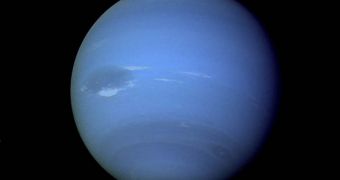Even though Neptune is one of the largest planets in our solar system, astronomers still know very little about how it works. Most of the phenomena going on at its surface are still a mystery to science, but recently astronomers managed to gain a few more insights into the celestial body's history. Using an European-built space telescope, a group of investigators managed to determine that the planet was very likely hit by a comet more than 200 years ago. The gas giant was observed using the Herschel Space Observatory, Space reports.
The instrument was launched together with the Planck Telescope aboard an Ariane 5 heavy-lift delivery system, and is currently the most complex observatory in space. Using the three sensitive scientific instruments aboard Herschel, experts learned that a peculiar distribution of carbon monoxide exists on Neptune, which is consistent with the comet hypothesis. The three detectors aboard the telescope are PACS (the Photodetecting Array Camera and Spectrometer), SPIRE (the Spectral and Photometric Imaging Receiver), and HIFI (the Heterodyne Instrument for the Far Infrared).
The work was conducted by a group of investigators from the Max Planck Institute for Solar System Research (MPS), which is based in Germany. The team published its findings in the July16 online issue of the esteemed scientific journal Astronomy & Astrophysics. Other cometary impact events, such as the one that saw comet Shoemaker-Levy 9 slam into Jupiter in 1994, provided the astronomers with the reference points they needed in trying to explain the carbon monoxide distribution patterns. “The higher concentration of carbon monoxide in the stratosphere can only be explained by an external origin. Normally, the concentrations of carbon monoxide in troposphere and stratosphere should be the same or decrease with increasing height,” says MPS expert Paul Hartogh.
He is also the principle investigator Herschel science program. The goal of the program is to analyze and understand the chemistry of water and related chemicals throughout the solar system. “From the distribution of carbon monoxide we can therefore derive the approximate time, when the impact took place,” MPS research scientist Thibault Cavalie adds. The German investigators used readings collected with the PACS instrument for this research.

 14 DAY TRIAL //
14 DAY TRIAL //